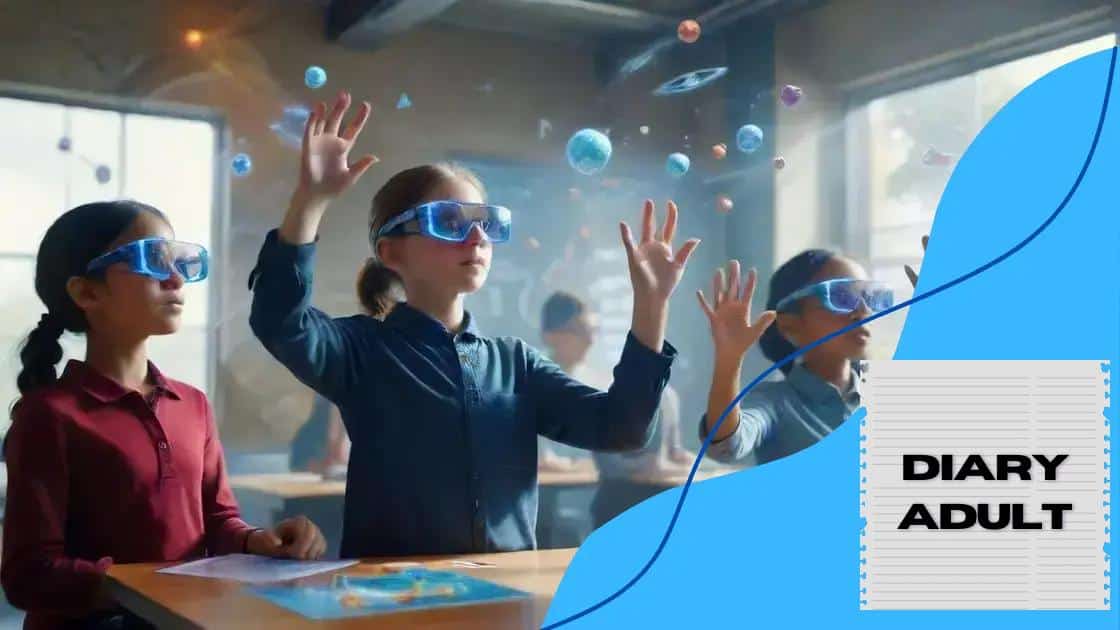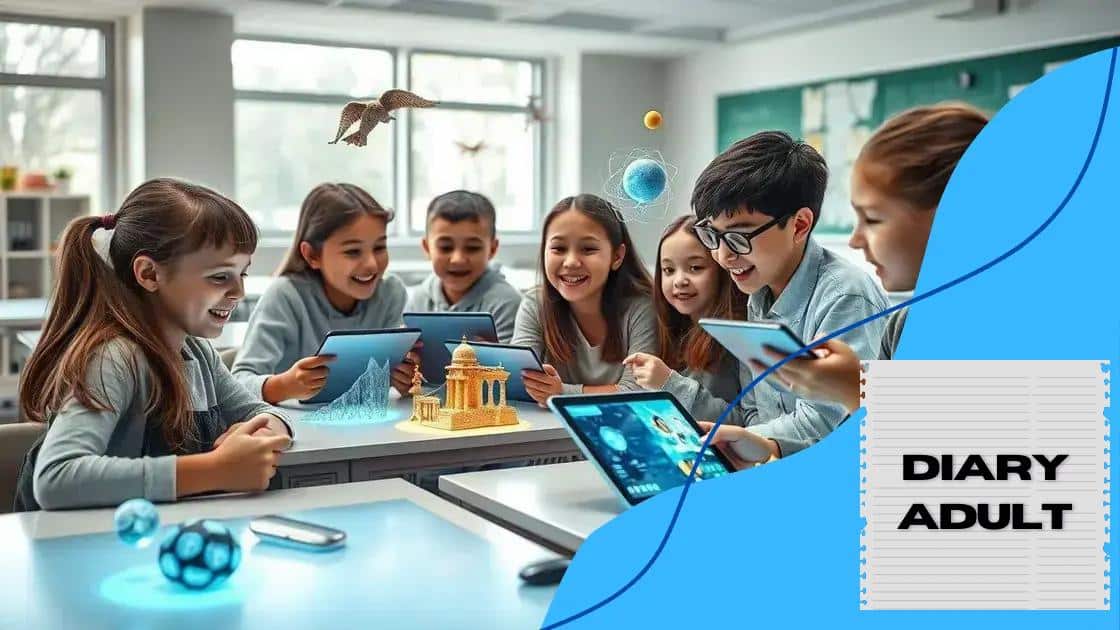How AR is being used for hands-on learning experiences

Augmented reality (AR) in education enhances hands-on learning experiences by providing interactive simulations, engaging visuals, and personalized lessons, while also presenting challenges like cost and technology integration.
How AR is being used for hands-on learning experiences is transforming traditional classrooms. Imagine being able to explore complex subjects like biology or astronomy through immersive, interactive simulations. Curious about how this technology enhances learning? Let’s dive in!
Understanding augmented reality in education
Understanding augmented reality in education is essential to grasp how it can reshape the learning experience. By blending digital elements with the real world, AR creates immersive environments that enhance understanding and retention.
This technology offers unique opportunities for learners. Imagine studying the solar system while viewing a 3D model right in your classroom. Such experiences make learning more engaging and interactive.
How AR Enhances Learning
AR tools allow students to visualize complex concepts in a way that is often challenging with traditional methods. For instance, in science classes, students can dissect virtual organisms, providing hands-on experiences that enhance their understanding. Engagement increases when learners interact with dynamic content.
- AR can make abstract concepts tangible.
- It fosters collaboration among students.
- Students can learn at their own pace by revisiting interactive materials.
As students interact with augmented environments, they often develop a deeper connection to the material. This immersion can lead to better retention of facts and concepts. By providing immediate feedback, AR helps learners recognize mistakes and correct them promptly.
Real-World Applications of AR in Classrooms
Many schools worldwide are beginning to integrate AR into their lesson plans. For example, history students can explore ancient civilizations through AR-enabled tours, offering a richer context for their studies. Moreover, subjects like geography benefit from AR visualizing terrain and climate data in real time.
With the rise of AR applications, teachers are discovering new ways to captivate student interest. By incorporating technology that aligns with their digital lifestyles, educators can boost participation levels. As AR continues to evolve, its potential to transform education seems limitless.
Benefits of AR for hands-on learning
The benefits of AR for hands-on learning are vast and remarkable. By incorporating augmented reality into the classroom, educators can enhance traditional teaching methods, making learning more engaging and efficient.
One major advantage is increased student engagement. When learners use AR tools, they experience lessons in an interactive way. This technology allows students to immerse themselves in subjects like science, history, and art by transforming lessons into exciting visual experiences.
Enhanced Understanding
AR provides a better grasp of complex concepts. For instance, students can visualize intricate scientific processes or explore historical events through 3D models. This clear representation of information aids retention and understanding, making learning both fun and effective.
- Students absorb knowledge through interaction.
- Visual learning helps clarify abstract ideas.
- Hands-on experiences foster curiosity and confidence.
Moreover, AR supports various learning styles. Some students benefit from visual elements, while others excel when they can interact with the material. This flexibility ensures that every learner can find their way to success. In addition, AR can provide immediate feedback during activities, allowing students to learn from their mistakes in real time.
Collaboration and Social Skills
Another significant benefit of AR is its ability to foster collaboration among students. Working together on AR projects encourages communication and teamwork skills. When students engage in group activities that utilize AR, they share ideas and learn from one another. This collaborative environment enhances the educational experience.
Furthermore, AR makes it easier for teachers to track student progress. Real-time data allows educators to adapt their teaching strategies, ensuring that all students remain on track. By utilizing AR, teachers can personalize their approach, catering to the unique needs and strengths of each student.
Examples of AR applications in classrooms

Examples of AR applications in classrooms provide insight into how this technology is transforming education. From interactive lessons to immersive experiences, AR makes learning dynamic and engaging. Educators around the world are embracing these tools to enhance their teaching methods.
One popular example is the use of AR apps like Google Expeditions. This application allows students to take virtual field trips to places such as historical sites or outer space, all from the convenience of their classroom. With just a smartphone or tablet, learners can explore environments they may never visit in real life.
Interactive Science Lessons
In science classes, AR is used to visualize processes such as the human anatomy or photosynthesis. Apps like Merge Cube allow students to hold virtual objects in their hands, making complex subjects easier to understand. By manipulating these objects, learners gain a deeper understanding of the subject matter.
- Visualize molecules in chemistry.
- Dissect virtual frogs in biology.
- Explore the solar system in astronomy.
Another example includes AR in language learning. Applications like Quiver allow students to color in images that come to life when viewed through a smartphone. As students animate their creations, they practice vocabulary and engage with language in a fun way.
History and Geography
AR also enriches history lessons with interactive timelines and 3D models of ancient structures. For geography, students can visualize topographical maps in 3D, helping them understand physical landscapes and how they interact with the environment. These applications bridge the gap between theoretical learning and real-world understanding.
Overall, the integration of AR into classroom settings opens doors to numerous possibilities. With these innovative tools, students can interact, collaborate, and learn actively, fostering a richer educational experience.
Challenges of implementing AR in education
The challenges of implementing AR in education are important to consider. While the benefits are clear, several obstacles can arise when integrating this technology into the classroom. Understanding these challenges helps educators prepare for a successful adoption.
One major hurdle is the cost associated with AR tools. Schools may struggle with budget limitations, making it difficult to acquire the necessary devices and software. Not all educational institutions can afford the latest technology, which can create disparities in access for students.
Technical Issues
Another significant challenge is the reliance on technology. Technical issues such as software glitches, internet connectivity problems, or compatibility issues with devices can disrupt lessons and frustrate both teachers and students. Educators need to be prepared to troubleshoot these problems quickly.
- Inconsistent access to reliable internet.
- Need for ongoing software updates.
- Potential hardware malfunctions.
Training teachers to effectively use AR in their lessons is also a crucial challenge. Many educators may not be familiar with how to incorporate AR into their teaching strategies. Professional development programs are essential for equipping teachers with the skills they need to create engaging AR experiences.
Equity and Accessibility
Equity is another concern. Not all students may have access to AR-capable devices at home, which can lead to inequality in learning opportunities. Schools must find ways to ensure that every student can benefit from AR, regardless of their personal resources.
Furthermore, curriculum alignment can be challenging. Teachers need to ensure that AR applications align with learning objectives and standards. This requires careful planning and coordination to make sure that AR enriches, rather than detracts from, essential learning goals.
Future of AR in educational environments
The future of AR in educational environments looks bright as this technology continues to evolve. With its potential to transform the way students learn, AR is likely to become an integral part of the educational landscape.
As technology advances, we can expect AR tools to become more accessible and affordable. Devices will become more powerful, enabling richer and more interactive learning experiences. This means students will be able to dive deeper into their studies with enhanced visualizations and simulations, making learning environments more engaging.
Personalized Learning Experiences
One key area for the future of AR in education is personalized learning. AR has the potential to adapt to individual students’ needs, allowing them to progress at their own pace. By using data analytics, AR applications can provide customized lessons that fit each learner’s strengths and weaknesses.
- Students can explore topics that interest them.
- Real-time feedback can guide their learning process.
- Tailored content helps maximize understanding.
Moreover, the integration of AR with other technologies, like artificial intelligence, will enable sophisticated learning experiences. For instance, AI can analyze a student’s performance and suggest specific AR activities to reinforce learning in those areas where they struggle.
Increased Collaboration
Collaboration among students is also set to improve. Future AR applications may allow students from different locations to work together in shared augmented spaces. This connectivity can foster teamwork and enhance social skills as students collaborate on projects and share ideas.
Additionally, as AR systems become more intuitive, educators can focus more on teaching strategies rather than the technology itself. Teachers will serve as facilitators, guiding students through their learning experiences, while AR tools handle the complex visuals and interactions.
Ultimately, the evolution of AR in education holds the promise of creating more dynamic, engaging, and effective learning environments. As we embrace these advances, the classroom will adapt to meet the needs of future generations of learners.
FAQ – Frequently Asked Questions about Augmented Reality in Education
What is augmented reality (AR) in education?
AR in education refers to the use of technology to overlay digital information in the real-world environment, enhancing learning experiences.
How can AR engage students in the classroom?
AR engages students by making lessons interactive and immersive, allowing them to visualize complex topics and participate actively in their learning.
What are some examples of AR applications used in schools?
Examples include Google Expeditions for virtual field trips, Merge Cube for interactive science lessons, and Quiver for animated art projects.
What challenges does AR face in educational settings?
Challenges include high costs, technical issues, the need for teacher training, and ensuring access for all students.





